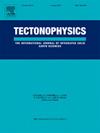基于重力、磁场和地震数据的西非和中非裂谷系统的地壳模型
IF 2.6
3区 地球科学
Q2 GEOCHEMISTRY & GEOPHYSICS
引用次数: 0
摘要
西非和中非裂谷系(WCARS)横跨多个地质域,包括剪切带、火山岩区和沉积盆地。它是喀麦隆火山线(CVL)和班吉磁异常(BMA)等关键地质特征的所在地。尽管进行了大量的研究,但对WCARS的详细地壳结构尚未完全了解。这项工作提出了一个全面的三维地壳研究,整合了重力、磁场和地震数据,为该地区的构造框架、裂谷动力学和BMA的形成提供了见解。密度、敏感性和地形数据的综合分析揭示了五个不同的构造单元,提供了对地壳组成和结构的精细理解。研究区主要断面的剖面图分析表明裂陷和岩浆活动对地壳减薄和密度分布的影响。中非剪切带(CASZ)和坎迪剪切带(KSZ)被认为是影响裂谷系统空间分布和演化的关键再活化断裂带。该研究还强调了岩浆活动的作用,由熔融物质上涌驱动,在改变地壳性质,特别是在火山地区,如CVL和贝努埃海槽。我们的研究结果表明,CVL、Benue海槽和BMA具有共同的构造成因,长英质和深部侵入对BMA的形成有贡献。这些结果增强了我们对西太平洋裂谷构造和地球动力学演化的认识,强调了原有构造和岩浆活动在塑造该地区裂谷构造中的作用。本文章由计算机程序翻译,如有差异,请以英文原文为准。
Crustal modelling across the West and Central African Rift System, based on gravity, magnetic and seismic data
The West and Central African Rift System (WCARS) extends over several geological domains, including shear zones, volcanic regions, and sedimentary basins. It is home to key geological features such as the Cameroon Volcanic Line (CVL) and the Bangui Magnetic Anomaly (BMA). Despite numerous studies, the detailed crustal structure of WCARS has not yet been fully understood. This work presents a comprehensive 3D crustal study that integrates gravity, magnetic, and seismic data, offering insights into the region’s tectonic framework, rift dynamics, and formation of the BMA. The combined analysis of density, susceptibility, and topographic data reveals five distinct tectonic units, providing a refined understanding of the crustal composition and structure. Analysis of cross-sections along key transects over the study area demonstrates the impact of rifting and magmatic activity on crustal thinning and density distribution. The Central African Shear Zone (CASZ) and the Kandi Shear Zone (KSZ) are identified as key reactivated fault zones that have influenced the spatial distribution and evolution of rift systems. The study also highlights the role of magmatism, driven by the upwelling of molten material, in modifying crustal properties, particularly in volcanic regions such as the CVL and the Benue trough. Our findings suggest a common tectonic origin for CVL, Benue trough, and BMA, with felsic and plutonic intrusions contributing to the formation of the BMA. These results enhance our understanding of the tectonic and geodynamic evolution of the WCARS, emphasizing the role of pre-existing structures and magmatism in shaping the region’s rift architecture.
求助全文
通过发布文献求助,成功后即可免费获取论文全文。
去求助
来源期刊

Tectonophysics
地学-地球化学与地球物理
CiteScore
4.90
自引率
6.90%
发文量
300
审稿时长
6 months
期刊介绍:
The prime focus of Tectonophysics will be high-impact original research and reviews in the fields of kinematics, structure, composition, and dynamics of the solid arth at all scales. Tectonophysics particularly encourages submission of papers based on the integration of a multitude of geophysical, geological, geochemical, geodynamic, and geotectonic methods
 求助内容:
求助内容: 应助结果提醒方式:
应助结果提醒方式:


